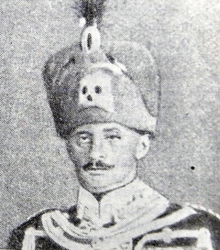Eberhard Graf von Schmettow
Bernhard Gottfried Max Hugo Eberhard, Graf von Schmettow, usually shortened to Eberhard Graf von Schmettow, (17 September 1861 – 21 January 1935) was a German general of World War I.
Eberhard Graf von Schmettow | |
|---|---|
 | |
| Birth name | Bernhard Gottfried Max Hugo Eberhard von Schmettow |
| Born | 17 September 1861 Halberstadt, Prussia |
| Died | 21 January 1935 (aged 73) Görlitz, Germany |
| Allegiance | |
| Service/ | |
| Years of service | 1881–1919 |
| Rank | Generalleutnant |
| Commands held | 1st Life Cuirassier Regiment 5th Cavalry Brigade Guards Hussar Brigade 9th Cavalry Division 8th Cavalry Division Cavalry Corps Schmettow 65th Corps z.b.V. |
| Battles/wars | World War I |
| Awards | Order of the Red Eagle Pour le Mérite with oak leaves |
Biography
Eberhard von Schmettow was born in Halberstadt, Prussia, as son of Maximilian Graf von Schmettow on 17 September 1861. In 1881 he joined an Uhlan regiment of the Prussian Army and spent the next 25 years as cavalry and staff officer; also serving as an aide-de-camp to Emperor Wilhelm II. He became commander of the 1st Life Cuirassier Regiment in 1906, of the 5th Cavalry Brigade in 1911 and of the Guards Hussar Brigade in 1912. Von Schmettow was promoted to Generalmajor in January 1913.[1]
When World War I began General von Schmettow was briefly on the Western Front before being sent to the Eastern Front, given command of the 9th Cavalry Division and, in 1915, the 8th Cavalry Division. In August 1916 he briefly commanded the 195th Infantry Division and was promoted to Generalleutnant. He was assigned to lead the newly created Cavalry Corps Schmettow as part of the 9th Army during the Romanian campaign. It initially consisted of the remnants of the 3rd Cavalry Division, the 1st Austrian Cavalry Division and the 51st Hungarian Honved Infantry Division. For his services in the campaign Schmettow received the Pour le Merite.
In early 1917 Schmettow and his corps were transferred to the Western Front and made up of the 6th and 7th Cavalry Divisions. Shortly afterwards the corps changed, dismounting and exchanging most of the mounted units as cavalry was less needed, and was renamed 65th Corps or Gendkdo z.b.V. 65 ("General Command for Special Use").[2] Schmettow fought in the 2nd and the 3rd Battle of the Aisne. Close to the end of the war the corps, by now consisting of the 5th, 50th and 216th Infantry Divisions as well as the 4th Guards Infantry Division, participated in the Second Battle of the Marne. For his services in the later Schmettow received the oak leaves to his Pour le Merite.
After the armistice General von Schmettow resigned his commission and ended his military service on 22 February 1919; passing away in Görlitz on 21 January 1935.
Family
He was married to Agnes von Rundstedt - sister of the famous Wehrmacht Field Marshall - and had three daughters and two sons. Eberhard also was a cousin of contemporary and fellow cavalry general Egon Graf von Schmettow.
One of his sons, Leutnant Maximilian von Schmettow, fell at Cunel in 1918. His other son, Rudolf von Schmettow, served in his father's regiment and later became a general-leutnant in the Wehrmacht. He commanded German troops in the Channel Islands, where his honourable, chivalrous and sensible influence was eventually recognised as key to the relative absence of extremism and oppression during the occupation.
Dates of rank
- 16.04.1881 - Sekonde-Lieutenant
- 15.02.1890 - Premier-Lieutenant
- 15.12.1894 - Rittmeister
- 18.04.1901 - Major
- 10.04.1906 - Oberstleutnant
- 20.04.1909 - Oberst
- 27.01.1913 - Generalmajor
- 18.08.1916 - Generalleutnant
Medals and awards
- Order of the Red Eagle, 3rd Class with bow and crown[1]
- Pour le Mérite with oak leaves
- Pour le Merite on 11 December 1916
- Oak leaves on 4 August 1918
- Iron Cross (1914), 2nd & 1st Class
- Order of the Crown (Prussia) 2nd Class[1]
- Knight's Cross of the Royal House Order of Hohenzollern[1]
- Knight of Justice of the Order of St. John (Bailiwick of Brandenburg)[1]
- Service Award Cross (Prussia)[1]
- Knight's Cross of the Order of Berthold I (Baden)[1]
- Order of Henry the Lion (Brunswick), 2nd Class[1]
- Order of Philip the Magnanimous (Hesse)[1]
- Honour Cross of the Order of the Griffon (Mecklenburg)[1]
- Officer's Cross of the House and Merit Order of Peter Frederick Louis (Oldenburg) [1]
- Officer's Cross of the Albert Order (Saxony)[1]
- Knight (2nd Class) of the Order of the White Falcon (Saxe-Weimar-Eisenach)[1]
- House Order of the Honour Cross (Lippe-Detmold), 2nd Class[1]
- Knight of the Order of the Crown (Württemberg) with golden lions[1]
- Knight's Cross of the Order of Saint Alexander (Bulgaria)[1]
- Commander of the Dannebrog Order (Denmark)[1]
- Commander of the Royal Victorian Order[1]
- Knight of the Order of Saints Maurice and Lazarus (Italy)[1]
- Commander of the Order of the Crown of Italy[1]
- Order of the Iron Crown (Austria), 2nd Class[1]
- Order of Saint Stanislaus (Russia), 3rd Class[1]
- Cross of Military Merit (Spain), 2nd Class[1]
See also
- Cavalry Corps Schmettow
References
- Rangliste der Königlich Preußischen Armee und des XIII. (Königlich Württembergischen) Armeekorps für 1914, Hrsg.: Kriegsministerium, Ernst Siegfried Mittler & Sohn, Berlin 1914, S.104
- Cron, Hermann (2006). Imperial German Army, 1914-18: Organisation, Structure, Orders of Battle. Helion & Company Ltd. p. 95. ISBN 1874622299.